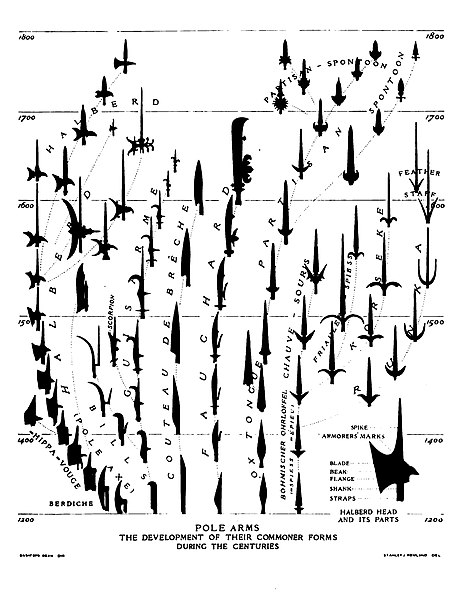A fauchard is a type of polearm which was used in Europe from the 11th through the 17th centuries.
In later use fauchards became ornamental and ceremonial, growing in size until some examples were almost too heavy to carry, let alone use.
The design consisted of a curved blade atop a long pole, although in some portrayals, it is shown on a shorter pole. The blade bore a moderate to strong curve along its length. The cutting edge was only on the convex side of the blade, unlike the guisarme or bill. The fauchard was likely developed from the war scythe with the cutting edge turned opposite, convex instead of concave, so that the weapon was good for both thrusting and slashing attacks.
"Coupe-marc", a French agricultural tool from the 19th or 20th century, often mislabeled as a fauchard. Most polearms originated from pole-mounted agricultural tools because of their heft and reach.
Soldiers with various polearms including a fauchard and glaive
Weapons in a French museum, illustrating differing name usage between languages. Left: A weapon called a fauchard, resembling a bill. Right: An ornate crescent-bladed halberd labelled "partisan".
Pole Arms: The Development of Their Commoner Forms During the Centuries (Fauchards are near the middle)
A war scythe or military scythe is a form of polearm with a curving single-edged blade with the cutting edge on the concave side of the blade. Its blade bears a superficial resemblance to that of an agricultural scythe from which it is likely to have evolved, but the war scythe is otherwise unrelated to agricultural tools and is a purpose-built infantry melee weapon. The blade of a war scythe has regularly proportioned flats, a thickness comparable to that of a spear or sword blade, and slightly curves along its edge as it tapers to its point. This is different from farming scythes, which have very thin and irregularly curved blades, specialised for mowing grass and wheat only, unsuitable as blades for improvised spears or polearms.
Illustration from Chrystian Piotr Aigner's "Krótka nauka o kosach i pikach" ("A Brief Treatise on Scythes and Pikes"), 1794
17th century Scottish war scythe
Mort de Bara by Jean-Joseph Weerts (1883), illustrating the use of the scythe
Artur Grottger, "Kucie kos" ("Forging of Scythes") during the January Uprising








